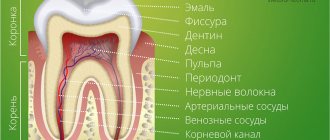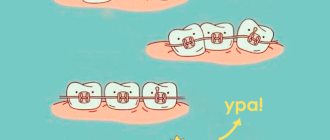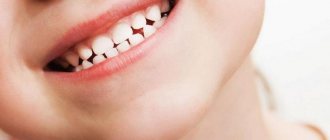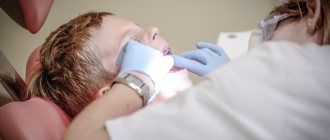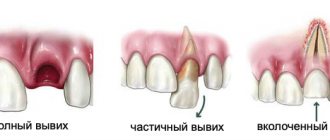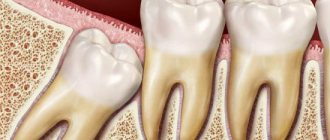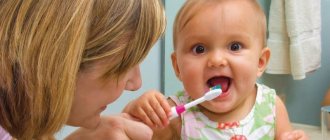The order of eruption of baby teeth
Everyone is different, but it is still important to know how most babies develop. Children's first teeth usually erupt almost simultaneously on the right and left. The sequence is as follows: first the anterior ones (incisors, canines), then the posterior ones.
It is important to understand that this pattern of teething in children is average, and in your case it may happen in a different order or at a different time. This does not necessarily indicate any violations.
Doctors have compiled an approximate, average diagram of teething in children:
Don't worry if you don't meet these standards for several months. If the parents got teeth late, most likely the children will have the same. Heredity has a very strong influence on development. The teething pattern should not become an unnecessary source of parental anxiety. This is just a guideline, like all other norms.
Both the sequence and timing of teething in children can vary greatly. Only if you are “late” by more than 6 months (for example, nothing appears until a year), it is worth discussing this with your doctor. There are genetic disorders when the rudiments of teeth do not develop at all. However, this is extremely rare. Some diseases also affect the timing of teething, but these conditions in children always manifest themselves with some more obvious symptoms.
In any case, there is no remedy that would “cut teeth” - we won’t pull them out of the jaw. We also do not regulate the cutting order. All that remains is to observe the process in children and take care of their health in general.
A child's teeth grow in two rows
With proper development of the jaw at the right age, permanent teeth begin to erupt and put pressure on the roots of the milk units.
Under this influence, the roots dissolve - the baby tooth becomes mobile, it wobbles and then falls out. This is a normal change in bite, the algorithm of which is known to most. But in rare cases the situation develops differently:
- when the germ of a permanent tooth and the root of the milk tooth are located in parallel planes, there is no pressure on the roots, and the permanent tooth grows in close proximity to the milk tooth;
- when the permanent one erupts quickly, and the roots of the milk unit have not yet resolved, the tooth does not fall out, and the permanent one has to bend and grow at an angle;
- when a child has a supernumerary set of teeth.
Various reasons - one result: the child’s teeth grow in the second row, threatening to ruin the permanent bite.
What problems may arise during teething in infants?
Difficulties do not always arise. But sometimes, about 3 days before and 3 days after teething, the baby’s condition changes:
- gums swell;
- saliva flows more strongly (although a lot of it can be released without connection with teething);
- the temperature rises slightly;
- mood deteriorates (child is less active, cries more often);
- sleep becomes restless;
- stools become slightly looser and more frequent;
- your cheeks turn slightly red (no need to immediately look for allergens and change your diet).
These symptoms may not all appear, in any combination.
The difficulty is that the same symptoms, but usually stronger, can also occur in children with infections. Therefore, if your condition has changed significantly, consult your doctor.
Red flags (tell your doctor if your child has):
- temperature above 38 degrees in the absence of cold symptoms;
- a rash that is unfamiliar to you, which appeared along with a high fever;
- diarrhea, vomiting;
- lethargy;
- mouth ulcers or other sores.
- Eruption cyst (hematoma).
Assess how much the child's condition has changed. If he begins to clearly feel unwell, there is no need to attribute this to the teething of baby teeth. In this case, you need a doctor to rule out more serious problems.
Why is the sequence broken?
The dentition is formed individually. This is influenced by many factors, for example, genetic predisposition. Therefore, the baby receives from the parents:
- Timing and order of birth of masticatory organs.
- Quality of enamel and strength of crowns.
If mom or dad had an incorrect pattern for the teething of units, the baby may also have them out of order. Non-standard appearance of units and discrepancies in terms are normal if:
- The baby tooth begins to emerge a month earlier or later;
- The order of appearance of the incisors is disrupted, that is, the upper one is born first, and then the lower one;
Remember that there is no method of influencing the time and speed of eruption in medicine. There are other reasons when a baby’s teeth grow out of order.
- Features of the pregnancy process, complications and illnesses of the mother: influenza, infectious diseases. Bad habits of a woman in labor have a negative impact.
- Infectious diseases that the child suffered: scarlet fever or measles.
- Lack of breastfeeding weakens the work of the newborn's facial muscles. His lower jaw does not develop enough, since sucking from a bottle is done with his lips. This provokes the initial appearance of incisors on the upper jaw.
- An ordinary pacifier if abused.
- Changes in climatic conditions.
- Parents of different nationalities.
These processes cannot be treated. It is important that all chewing organs come out so as not to miss the child’s gum inflammation. Medicine is not aware of cases where children are left without incisors and molars due to unbalanced eruption of units. They will grow up, you need to wait and take care of the little one.
Medicines for teething in children
When your baby is in pain, you would like to have a reliable, effective medicine that you can give and sleep peacefully. As in the case of colic, when teething, the pharmacy will offer you a variety of remedies. Pediatric experts do not advise giving any medications without a doctor's permission.
Why? Homeopathic medicines are divided into true homeopathic (containing no active substance at all, and therefore ineffective) or pseudo-homeopathic. The latter contain some amount of plant components (usually chamomile and other, more exotic plants). The first ones do not work under any conditions, including teething in children, but at least they are harmless. Homeopathic remedies for pain containing belladonna (which was not even always listed in the composition) caused many deaths and were therefore strictly prohibited in developed countries.
In our country, the Commission of the Russian Academy of Sciences recognized homeopathy as a pseudoscience, but, unfortunately, there is no strict ban on potentially dangerous drugs. Since manufacturers do not always indicate belladonna in the composition, we recommend that you generally refrain from using any homeopathic remedies for teething pain in children.
Another case is gels with a local anesthetic drug (their name ends in “-caine”: usually benzocaine or lidocaine). Medicines like these are “freezes” that are injected into the gums when treating teeth. Although these drugs are obviously effective, they have also caused many child deaths. Substances of this group affect the functioning of the heart, because the gel is quickly washed off with saliva, and the child swallows it. It is especially dangerous if the parent uses a higher dose than recommended in the instructions. This happens often because these drugs only relieve pain for a few minutes. When the baby starts crying again, the parents apply more, often exceeding the dose. Now professional communities of doctors do not recommend the use of products with local anesthetics, but this does not stop their widespread advertising.
What to do if your teeth are cutting incorrectly
First of all, don't panic. When your toddler's teeth are cut out of order, balance his diet. After 5-6 months, a child, in addition to mother's milk, should receive complementary foods. It is important to measure the time of wakefulness and sleep. It is necessary to take the baby to the pediatrician for examination in a timely manner. If he prescribes a complex of vitamins, you must take them. Self-selection of medications can harm the child’s health.
The baby should be examined by a pediatric orthodontist. If there are no developmental pathologies, there is no need to worry. An objective assessment of the condition is the main criterion of health. If units emerge out of order, doctors advise observation and not skipping preventive examinations. When a one-year-old baby’s chewing organs do not grow, this is a reason for examination. This situation indicates a disturbance in metabolic processes. Violations in the order of birth of teeth should be closely monitored and reacted only if necessary.
What to do when children are teething?
The most natural and one of the most reliable ways to reduce pain is cold. Pick up an item - a “rodent” that can be put in the refrigerator. Freezing them is not recommended because it can damage the baby's delicate gums.
Often children prefer to gnaw on their parent's finger or, unfortunately, on their mother's breast. But parents may not have enough patience for a long time, so it is better to find a suitable teether.
It should be:
- whole and durable (the child should not bite off pieces that could cause choking);
- without ropes and beads (the rope can pinch the neck or break, creating a risk of choking on a bead);
- without paint with toxic components;
- just clean (no need to disinfect it).
You can refrigerate the fruit puree or put a few wet cloth toys in the refrigerator so you can replace them.
Of course, children chew not only objects that are ideal for this. But if with a teether made of one piece of silicone or a mitten with a silicone pad the child can be left alone in the playpen for some time, then with a bunch of small objects on a string around the neck or a bracelet made of beads, the same as with some fruit or vegetable, you need to look after it.
If cooling does not help, and the stress of teething is very severe, discuss taking pain relievers and fever reducers (ibuprofen is most often used) with your pediatrician. To be on the safe side, consult your doctor, but a single dose by weight (for ibuprofen is 10 mg/kg), given once at night for 3-4 days of active teething, will not cause harm.
The appearance of a second row of teeth in the jaw
Each canine, incisor and molar has its own place, but sometimes a child's permanent teeth begin to form a second row. This often happens when the milky ones have not yet fallen out, but the radical ones have already begun to appear. An undeveloped jaw that provides too little room for growth can also be a source of the problem. The third reason is that the incisors and canines in the second row are “superfluous”, or supernumerary.
The second row of teeth is not only inconvenient, but also unsightly, so the problem needs to be solved. A baby tooth that does not fall out in time can be removed in the clinic. If the reason for the formation of the second row is underdevelopment of the jaw, then the dentist can remove several teeth and install braces on the remaining ones.
Should I brush my newly erupted teeth?
Dentists strongly recommend starting to take care of oral hygiene from infancy. For newly emerging teeth, they offer special silicone brushes or wipes. A simpler option is a finger wrapped in gauze. You can simply moisten it with water or use toothpastes for children under 3 years of age (they are marked 0+ and can always be swallowed). The main thing when brushing your teeth is no violence! A little more cleanliness isn't worth the stress.
| Author Fedor Katasonov | Scientific editor Maria Gantman |
In what cases can a child grow a second row of baby teeth?
The rudiments of baby teeth are formed very early, even before the baby is born, so disturbances in their growth are a consequence of the lack of space in the jaw to accommodate all the teeth.
What can lead to improper formation of buds or insufficient jaw size?
- Poor nutrition of a woman during pregnancy. For the proper formation of the baby’s body, including his future teeth, it is necessary that the mother receives vitamins and minerals in the quantities that she and the child need. If there are not enough of them, then the deficiency can lead to disruption or slowdown in the growth of both the rudiments of future teeth and the jaw bone.
- Lack of calcium and fluoride as the main elements for maintaining dental health in a child’s diet. It is necessary to carefully monitor how the baby eats so that the peculiarities of food do not become a problem for him and his teeth in the future.
- Avoiding solid foods in the infant's diet. Gnawing on harder foods is a necessary action that helps to properly position the erupting baby teeth in the jaw. If the baby receives only soft or liquid food, then he does not have the opportunity to correctly identify the places for all the baby teeth.
- Genetic predisposition to problematic growth of baby teeth. Unfortunately, genetics also influences crooked teeth. But don’t worry, because modern pediatric dentistry offers many ways to correct a child’s bite without much worry for both him and his parents.
Teeth are growing incorrectly - can this be corrected?
Of course, there are ways to correct disturbances in the growth of both primary and permanent teeth, including the growth of their second row in a child - it is difficult; a dental plate most likely will not help. You can often hear a myth that the incorrect growth of temporary teeth does not need to be corrected, because with age they are still replaced by permanent ones. This is a fundamentally wrong approach. In addition to the child developing complexes and frequent pain from malocclusion, curvature of baby teeth can lead to growth disturbances in permanent teeth, which is much more difficult to correct.
However, if permanent teeth require correction, then this is also not a reason to be too upset: orthodontists can recommend a lot of ways to correct abnormal growth of permanent teeth (aligners, trainers, braces).
Braces are placed at older ages - teenagers or adults. Since at this time the roots of permanent teeth are already formed, correction takes much longer than if it began in childhood. Often, wearing braces lasts for a year and a half, and sometimes for longer.
Whereas a doctor may prescribe a mouthguard or trainer for a child. In general, when correcting a bite, the rule is true: the sooner the better, which should always be kept in mind when detecting any problems with the arrangement of teeth in the jaw.
Of course, during the correction it is also necessary to maintain careful oral hygiene. Correction systems in the mouth can trap pieces of food, which subsequently become a good environment for microorganisms. This can lead to problems with the enamel, and in the longer term, even to caries and tooth decay.
Therefore, Asepta recommends using products to ensure oral hygiene. We have developed toothpastes specifically for children - they carefully clean, protect enamel from caries, and saturate it with minerals. Pastes also help get rid of food debris and prevent the proliferation of microorganisms on the teeth while wearing correction systems, and the antiseptic component in their composition helps disinfect the oral cavity.
What to do if a child’s tooth grows in the second row?
Sometimes such teeth sit so tightly in the gums that only their surgical removal can solve the problem. If precious time was missed, during which it was possible to easily return the permanent teeth to their place or allow them to erupt correctly, then retention may occur. Retention is the incomplete eruption of a tooth, in which it remains a small part inside the gum or, conversely, is almost completely hidden in it. It is much more difficult to correct than correcting abnormally growing permanent teeth. Therefore, it is worth paying attention to problems with a child’s bite as early as possible, even before his temporary teeth begin to change to permanent ones.
Only a dentist can make any decision regarding an impacted tooth and only after a complete examination of the small patient’s jaw. To do this, a complete photograph of the jaw is taken, which clearly shows the location of the tooth and possible paths of development of events. Next, the doctor may resort to either making an incision in the gum, followed by installing a brace system on the teeth, or removing the tooth, if nothing can be done to help. The latter, however, rarely happens. More often than not, doctors try to find a way out of any situation, and braces systems currently make it possible to solve almost any problem with an impacted tooth.
Therefore, if you notice that your child is growing second row of milk or permanent teeth, you should not panic, but you should not lose sight of the situation either. Make an appointment with a doctor and get examined. The dentist will assess the situation and offer the best approach to solving the problem. Early contact with a doctor is the key to quick treatment.
Take care of the health of your loved ones with Asepta!
Can the physiological process of teething in infants be pathological?
I.N.ZAKHAROVA, Doctor of Medical Sciences, Professor, I.N. KHOLODOVA, Doctor of Medical Sciences, Professor, Yu.L. DMITRIEVA, Ph.D., N.V. MOROZOVA, MD, M.V. MOZZHUKHIN, D.I. KOLODOV
Russian Medical Academy of Postgraduate Education, Moscow
The article discusses the problem of teething in infants, listing the mechanisms and factors influencing this process. Scientific studies are presented that show the significance of various clinical symptoms during teething in children, the dependence of this process on the type of constitution of the child, and also the issues of modern therapy for pathological teething are considered.
Key words: infants, constitutional type of children, teething, pathological symptoms, homeopathic medicines.
Teething is one of the stages in the development of a baby's teeth. This period is determined by the growth and development of the baby and is considered as a physiological process that is in close connection not only with the general state of health, but also with its constitution. In most children, teething does not cause any serious complications or complaints [1]. However, in a number of infants, teething affects his well-being, causing certain pathological symptoms.
The eruption of primary teeth is influenced by various factors. A number of researchers believe that the main significance in the process of teething is the human genotype and his constitution, although the role of various external environmental factors cannot be ruled out. Some dentists believe that children of elderly parents erupt teeth somewhat earlier than children of young parents. First-born children begin to erupt teeth earlier than second and third children, and girls begin to erupt a little earlier than boys [2]. Many experts note that there is a direct relationship between the degree of prematurity of the child and the timing of the eruption of baby teeth. Thus, in healthy premature children, the timing of the eruption of baby teeth generally corresponds to those in healthy full-term children. In premature infants with a history of complicated neonatal period (intracranial birth injury, infectious and inflammatory diseases), this process begins at a later date (at 11-12 months and after a year) and depends on the severity of the pathology suffered. Features of the mother's pregnancy also influence the physiology of teething. There is evidence that in children whose mothers suffered from toxicosis during pregnancy, the eruption of baby teeth is delayed. Some authors believe that the eruption of primary teeth occurs at a later date in children born to mothers with congenital heart defects. Diseases suffered during the first year of life are of great importance in the formation of a child’s dental system. Many researchers note that with rickets, the appearance of baby teeth occurs late and in violation of the correct order [3].
There are several theories explaining the process of teething, among which the most convincing are the following [4]:
- Hunter's theory, according to which the growing roots of the tooth abut the hard bony bottom of the bony alveolus and the tooth is pushed out of the bony alveolus;
- Yasvoin's theory, according to which the cause of teething is the differentiation processes occurring in the tissue of the dental papilla, as a result of which a large amount of basic substance accumulates there. The increase in pulp volume creates pressure inside the tooth germ, which forces it to move towards the free edge of the gum;
- Katz's theory, which believes that the growing tooth puts pressure on the lateral walls of the alveoli, which leads to superficial bone resorption. At the same time, new bone is deposited on the outer surface of the alveolar processes and on its upper edge. Bone tissue accumulates in the area of the bottom of the alveolus, which leads to an increase in tissue pressure there, pushing the tooth to the surface.
It should be noted that none of these theories can fully explain the complex mechanism of teething. By the time the tooth erupts, the area of bone covering the crown of the tooth is reabsorbed. The same processes are observed in the gums. During the growth of the tooth root, bone restructuring and gradual deepening of the dental alveoli also occur. At the same time, morphological changes occur in the tissues surrounding the tooth: increased blood flow, changes in vascular permeability, increased production of the main substance of the pulp and periodontium [5].
The eruption of baby teeth usually begins at 6-7 months of age. By this time, the development of the crown of the baby tooth ends and the formation of its root begins. The connective tissue of the gums, lying in the path of the erupting tooth, is gradually compressed and atrophies. The reduced enamel epithelium covering the crown of the tooth comes into contact with the gingival epithelium and merges with it. Following this, a breakthrough of the epithelium occurs above the apex of the crown, and it appears in the oral cavity. As the tooth erupts, the epithelium of the gum margin surrounding it turns into a reduced enamel epithelium, covering the not yet erupted part of the tooth crown. This epithelium grows tightly together with the enamel shell and gradually separates from it only during the eruption of the tooth crown. However, even after the end of tooth eruption, this epithelium remains in the area of the lower third or quarter of the tooth crown. Located in the form of a thin border around the neck of the tooth, it forms the so-called. epithelial attachment, or gingival margin. Where the epithelium departs from the surface of the enamel, the bottom of the gingival crevice, or pocket, appears.
Can the physiological process of teething be complicated by any pathological symptoms? In 2002, American researchers published the results of a survey, the purpose of which was to establish the attitude of pediatricians, pediatric dentists and parents to various symptoms most often associated with teething. Most respondents tended to associate teething in babies with symptoms such as fever, restlessness, swollen gums, increased drooling and sleep disturbances. When comparing the answer options between the groups of respondents who took part in the survey, it was noted that the last three symptoms were significantly more often associated by parents and dentists with the dental process. The most significant differences in the attitude of the respondents were obtained regarding changes in stool character as a symptom of teething. The majority of parents (56.7%) and dentists (52.0%) were convinced that the connection was obvious, while only 9.1% of pediatricians supported this point of view [6]. The works of other foreign authors [7, 8, 9] noted that the appearance of drooling, fever, desire to bite, dermatitis on the chin, cheeks, neck associated with irritation with saliva, rhinitis, wet cough and pasty stool against the background of teething is observed in 35-60% of children. In this case, the temperature rise does not exceed 38 ° C and lasts no more than 1-2 days. Fever is caused by the release of biologically active substances in the tooth growth zone and resolves on its own soon after its eruption [8,10]. A change in consistency towards liquefaction or increased frequency of stools is caused by the release of a large amount of saliva, which stimulates intestinal motility [8,10].
In 2012, we, together with employees of the Department of Pediatrics of the State Budget Educational Institution of Higher Professional Education YAGMA of the Ministry of Health of the Russian Federation, conducted a survey of 50 local doctors. To the question: “Do you often encounter children in the first year of life with painful teething syndrome?” — 46% of doctors answered that in approximately 10-30% of cases. Of the symptoms most often accompanying teething, pediatricians ranked increased drooling in first place, followed by the desire to bite, irritability, refusal to eat and increased body temperature. More than 60% of doctors indicated that teething syndrome is often combined with manifestations of acute respiratory infection. Doctors explained this fact by the fact that against the background of teething, the child’s body’s resistance to viruses and bacteria decreases.
Researchers from Cleveland conducted a large prospective study, the purpose of which was to establish the most characteristic symptoms of teething [7]. The work included 125 infants who were monitored from 4 months. up to 1 year. At the same time, parents recorded tympanic temperature daily and noted the possible presence of one or more of the 18 symptoms offered in the child. The authors found that symptoms such as increased salivation, swelling of the gums, anxiety, sleep disturbance, facial flushing, decreased appetite for solid food and a slight increase in body temperature were statistically significantly associated with the dental process. However, significant differences were recorded only for 8 days (4 days before, on the day of teething and 3 days after teething), which allowed the authors to call this period the “eight-day teething window.” The period identified by the authors allows the doctor to navigate in terms of the duration of therapy: 7-8 days. Dilution of stool or an increase in its frequency, decreased appetite for liquid food, cough, the appearance of dermatitis, vomiting and an increase in body temperature above 38.5 °C were not significantly associated with the process of teething, but more often corresponded to the onset of an acute respiratory disease [7].
A similar prospective study was conducted by Brazilian authors [11]. 47 children aged 5 to 15 months were taken under observation. During the study period, children underwent daily measurement of tympanic and axillary temperature, examination of the oral cavity and registration of possible symptoms of dentition. Based on the results of the analysis of the data obtained, it was found that the process of teething was significantly associated with an increase in tympanic temperature on the day of tooth emergence, as well as the presence of symptoms such as irritability (p < 0.001), increased salivation (p < 0.001), rhinorrhea (p < 0.001 ) and decreased appetite (p < 0.001) [11].
Our own observations of children showed that in children of different types of constitution this process proceeds differently (Table 2). Thus, in children with a lymphatic-hypoplastic type of constitution, which are characterized by lymphadenopathy, excess body weight, a tendency to atopic dermatitis and rickets, as a rule, the eruption of primary teeth occurs late and in the wrong order. They usually experience severe anxiety, crying, abnormal bowel habits, swelling and soreness of the gums, and excessive salivation. A significant delay in teething may be a consequence of pathology of the endocrine system, in particular congenital or transient hypothyroidism [12].
In a number of children who can be classified as having a neuro-arthritic type of constitution, the first teeth, as a rule, appear on time, but their eruption is often accompanied by severe pain, excitability, episodes of crying for several hours, and sleep disturbances. Refusal to eat, regurgitation and vomiting may occur. It is these children who, when teething, may have a rise in temperature up to febrile levels. Children of this type of constitution usually have good growth, underweight, they are hyperactive, excitable, they are characterized by imbalance, causeless rises in temperature, regurgitation, vomiting, and acetone states (Table 1).
In children with an allergic type of constitution, the process of teething is often accompanied by the appearance or exacerbation of allergic dermatitis, stool upset, tearfulness, and loss of appetite. In these children, during teething, acute respiratory infections are often associated, which is probably due to their characteristic features: lability of water-salt metabolism, anaerobic type of metabolism, excessive histamine synthesis, decreased phagocytosis activity, increased permeability of the vascular wall.
Thus, the information available in the literature allows us to conclude that in a number of children the process of teething may be accompanied by pathological symptoms and impairment. Unfortunately, in not a single scientific study have we been able to identify symptoms that could reliably indicate teething and would allow us to make a differential diagnosis between this process and an incipient acute respiratory infection. Knowing the type of constitution allows you to predict how teething will proceed in each individual child, and plan preventive measures aimed at reducing pathological symptoms in this situation.
To make teething easier for your baby, you need to:
- give him more attention from his parents;
- more frequent breastfeeding, which has a sedative effect and increases resistance to infections;
- Invite the child to pick up a teether, which should be clean, preferably cool. because such material, when in contact with the gums, slightly soothes pain and reduces inflammation;
- massage the gums, for which you need to wrap your index finger with a gauze swab dipped in cold water and gently massage the child’s gums;
- provide gentle care for the skin around the mouth;
- use medications if necessary.
There are many drugs that facilitate teething, most of them exist in the form of gels (Table 2).
The disadvantages of using these products include the short-term effect of the gel due to its rapid rinsing with saliva, as well as the possibility of developing allergic reactions to its components [10]. In addition, to improve the general condition and reduce the temperature, drugs such as paracetamol and gels with a local anesthetic effect are used. Frequent use of these drugs may contribute to the development of unwanted side reactions and toxic effects.
When teething, you can use natural remedies (homeopathic medicines). The works of a number of authors have shown their high efficiency and safety, including in pathological teething [13,14,15,16, 17,18,19]. Complex homeopathic preparations are non-toxic and are effective and safe. The prescription of complex homeopathic medicines makes it possible to make a differential diagnosis between teething and an incipient acute respiratory infection. If pathological symptoms are associated with teething, they usually stop or decrease by the second day from the start of treatment with homeopathic medicines [17,19]. If the baby does not feel better after 1-2 days of therapy, it is necessary to reconsider your treatment tactics towards the treatment of an acute respiratory infection.
One of the homeopathic medicines is Dentokind tablets. Dentokind contains the following components: belladonna - belladonna. This drug has been used in France since 1994 in children in the form of an oral solution. Dantinorm Baby contains components that can affect teething symptoms: chamomile (Chamomilla vulgaris), which is traditionally used to relieve pain, has an anti-inflammatory and soothing effect; "Indian ivy" (Phytolacca decandra), used to reduce soreness and inflammation of the gums; Rhubarb (Rheum officinale), used for digestive disorders, affects intestinal motility and helps eliminate diarrhea. The drug is used in one dose 2-3 times a day in between feedings for 3 days.
For ease of use, I have developed special hygienic packaging: dosed polyethylene containers, each of which corresponds to one dose of the drug, which can be easily dropped into the child’s mouth, avoiding contact of the solution with hands. You can give the drug not only at home, but also while walking.
“To date, there have not been any cases of side effects of the drug and/or allergic reactions; it can be combined with the use of other drugs. In a randomized multicenter study [18,19], 597 children aged 3 to 24 months were observed. with symptoms of teething, while 97% of children had local symptoms, and 94% had general ones. Children received several treatment options: 1st treatment option - homeopathic medicine only, or systemic analgesics, or dental gels; The 2nd treatment option is the combined use of these drugs. The drug Dantinorm Baby (French name CamiUia) was received by 71% of children as monotherapy and in combination with other drugs; systemic analgesics - 69%; dental gels - 64% of children. After 7 days of therapy, improvement or complete absence of pathological
symptoms were noted in 94% of children receiving CamiUia (Dantinorm Baby) as part of therapy. Note that 81% of the parents of these children were completely satisfied with the effectiveness of the treatment.
This study showed that the complex homeopathic drug Dantinorm Baby can be successfully prescribed in the treatment of pathological teething. Dantinorm Baby is especially indicated for children with changes in stool character and diarrhea due to teething, when rectal suppositories are difficult to use, and in cases where severe pain in the gums does not allow the use of other dosage forms and the child even refuses to drink. Therefore, the use of the drug from sterile single-dose containers in drops is optimal.
Thus, in modern conditions, it is necessary to conduct further research aimed at identifying the most significant signs of teething, and differential diagnosis with other pathological conditions (acute respiratory infection, functional disorders of the gastrointestinal tract). The use of natural products in children opens up prospects in the treatment of pathological teething in children. This therapy is safe and effective.
LITERATURE
1. Tatochenko V.K. Pediatrician for every day. 2007. 5th ed., revised. and additional M., 2007.272 p.
2. Belousova N.A., Belousova E.G.. Caring for a healthy child: development and eruption of baby teeth. District pediatrician, 2009.1: 7.
3. Persii L.S., Elizarova V.M., Dyakova S.V. Pediatric dentistry. 5th ed., revised. and dollars M.: Medicine, 2003. p.43-45.
4. Pediatric therapeutic dentistry: national guidelines. Ed. VC. Leontyeva, L.P. Kiselnikova. M.: GEOTAR-Media, 2010.896 p.
5. Gaivoronsky I.V., Petrova T.B. Anatomy of human teeth. Tutorial. St. Petersburg: ELBI-SPb, 2005. 56 p.
6. Barlow BS, KaneLlis MJ, SLayton RL Tooth eruption symptoms: a survey of parents and health professionals. ASDCJ Dent Child, 2002 May-Aug, 69(2): 148-50,123-4,
7. Macknin ML, Piedmonte M, Jacobs J, Skibinski C. Symptoms associated with infant teething: a prospective study. Pediatrics, 2000 Apr, 105(4 Pt 1}: 747-52.
8. Perets B, Ram D, Hermida L et at Sistemic manifestation during eruption of primary teeth in Infants./ Dent child., 2003,70:170-173.
9. Cunha RF, Pugliesi LM, Garcia LD et aL Sistemic and local teething disturbances: prevalence in a clinic for infants./ Dent child., 2004,71: 24-26.
10. Tsong AKL.Teething, teething pain and teething remedies, int. DentmAns Ed, 2010,5(4): 14-28.
11. Ramos-Jorge J, Pordeus IA, Ramos-Jorge ML, Paiva SM. Prospective longitudinal study of signs and symptoms associated with primary tooth eruption. Pediatrics, 2011 Sep, 128(3): 471-6.
12. Persii L.S., Elizarova BM, Dyakova SV. Pediatric dentistry. Ed. 5th, revised and additional M.; Medicine, 2003. pp. 43-45.
13. Bedareva T.P. Antihomotoxic therapy as a necessary stage in the rehabilitation of children with diseases of the digestive system. Biol. Med., 2000,2:48-51.
14. Ilyenko L.I., Syryeva T.N., Kholodov D.I., Gainova L.V., Semashina G.A. The use of natural products for pathological dentition in children of the first years of life. Questions of Pediatric Dietetics, 2011,9,2:2-4.
15. Shpigel A.S. Evaluation of the effectiveness of antihomotoxic pharmacotherapy in accordance with the principles of evidence-based medicine. Viol Med 2002,2:56-64.
16. Kurz R, Clinical medicine versus homeopathy. Pediatr. Padol., 1992,27: 37-41.
17. Ilyenko L.I., Kholodova I.N., Syryeva T.N., Kholodov D.I., Ilyina ID. New opportunities to improve the quality of life of children with painful teething. Pediatrics 2010,89, 4:106-110.
18. Kazyukova T.V., Kotlukov V.K., Shevchenko N.N., Rusakova VD Symptoms of teething in infants: condition or disease? Pediatrics 2013,92,4:1-5.
19. Stagnara J, Besse R, Feyard AL et aL P174. Symptomatologie et prise en charge de la pausse dentaire. Archives de p'diotrie, 2010,17{6S1): 93-94. Doi: 10.1016/S0929-693X (10) 705 74-1.
Published: Medical Council, No. 01, 2021.
On terms of commercial partnership
Read the instructions
What are baby teeth?
A child may believe that baby teeth are needed only so that the Tooth Fairy has something to build her snow-white castle from. But adults should know the truth. When a child is still very small, his head, and therefore his jaw, are small. If the baby, instead of milk teeth, began to cut molars immediately, they would not fit into the mouth either in size or in number. Therefore, nature gave us a temporary solution for the first ten years.
There are 20 primary teeth in total (10 each on the upper and lower jaws). These are incisors - central and lateral, canines, and molars. Usually, a child already has all of them at the age of 3-3.5 years.
Milk teeth differ from primary teeth not only in size, but also in structure. The enamel of primary teeth is approximately 2 times thinner and not as rich in minerals. Therefore, the child needs to carefully monitor oral hygiene - caries on baby teeth develops very quickly. Milk teeth have thin not only enamel, but also the layer underneath it - dentin - so caries quickly develops into pulpitis. Baby teeth have both nerves and roots, but they are shorter than molars. The latter gradually “dissolve” during the period of change of bite. This is why the teeth begin to loosen.
If baby teeth are not taken care of and treated, the child’s gums may become inflamed, and the embryos of the molars may suffer or die. Don't leave caries unattended!
Publications in the media
Teething is a physiological stage process characterized by the appearance of milk and then permanent teeth. Most children tolerate the appearance of teeth satisfactorily. Teeth erupt in a certain sequence, variations are possible.
Embryology and physiology • The formation of teeth occurs on the 40th day of embryogenesis • The newborn has no teeth. Possible birth of a child (1 case in 2,000 newborns) with teeth (usually with one of the lower central incisors) • Milk teeth •• First teeth erupt at the age of 6–8 months •• Sequence of eruption: lower middle incisors, upper middle and upper lateral ; at the end of the first year - lower lateral incisors •• A 1 year old child has 8 teeth. By the age of 2 years, the eruption of all 20 milk teeth ends •• Formula for determining the proper number of teeth in a child aged 6–24 months: n - 4, where n is the child’s age in months • Permanent teeth •• Beginning of eruption of permanent teeth - 5 years • • The replacement of one tooth occurs within 3–4 months •• The replacement of primary teeth with permanent ones forms a mixed bite •• The sequence of eruption: first the first molars appear; the further sequence of eruption of permanent teeth is similar to the appearance of milk teeth; at the age of 11, second molars appear, third molars (“wisdom teeth”) erupt at the age of 17 to 25 years or later •• In girls, teething occurs with some advance •• Formula for determining the proper number of teeth in children over 2 years of age: 4n — 20, where n is the number of complete years of the child • Delayed teething •• Occurs in 25% of cases with normal psychomotor development of the child •• The order of teething is often disturbed •• The reasons for late teething are pathological conditions associated with impaired calcium metabolism (rickets, hypothyroidism ), acute infectious diseases •• In premature infants, gestational age (not calendar age) must be taken into account when assessing tooth eruption.
Clinical picture • Often teething does not affect the general condition of the child and occurs without clinical symptoms • Hypersalivation • Swelling and itching of the gums. Hyperemia of the mucous membrane, single petechiae • Difficult teething (dentitio difficalis) is characterized by general malaise, anxiety, and insomnia. Possible increase in body temperature to subfebrile levels, mild dyspeptic symptoms, skin rashes of an allergic nature • The listed symptoms can be regarded as a manifestation of teething only after more serious causes of the child’s condition have been excluded. Differential diagnosis • Viral gingivostomatitis (eg, herpetic gingivostomatitis) • Acute intestinal infections • Respiratory diseases. Management tactics • Treatment is symptomatic • Massage of swollen gums with soft rings for teeth, clean cotton scarves • Mechanically and physically gentle food • Obligate allergens must be excluded from the diet • In children with low-grade body temperature, severe local inflammatory changes in the gums, antipyretics are used per rectum • Teething is not considered an indication for interrupting breastfeeding.
ICD-10 • K00 Disorders of development and eruption of teeth
